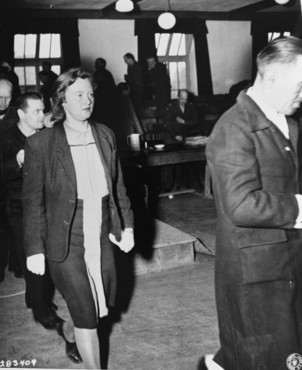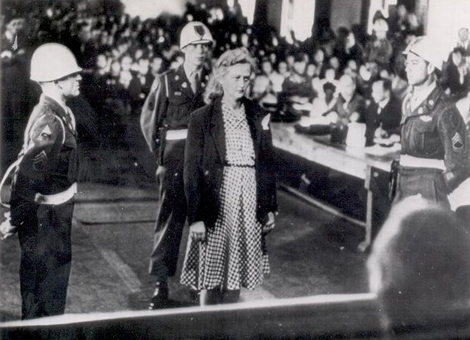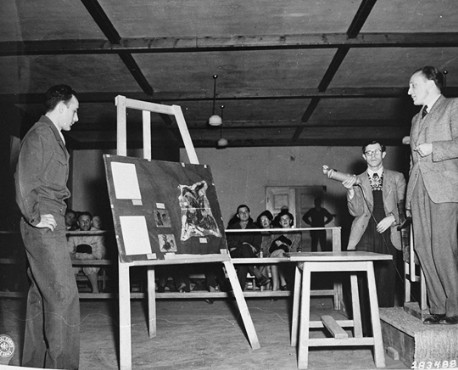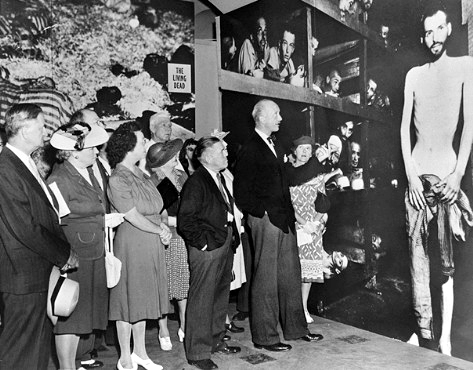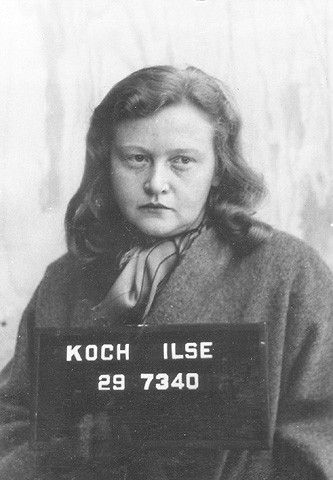The Trial of Ilse Koch
Karl Koch
The internet video Buchenwald: A Dumb Dumb Portrayal of Evil (2008) makes the assertion that Psyche Warfare planted evidence at Buchenwald. Seeing Things by John Ellis (published by I.B. Taurus in 2000) mentions Billy Wilder forcing German audiences to watch footage of Buchenwald in order to receive bread rations. The movie Buchenwald: A Dumb Dumb Portrayal Of Evil Episode 2 points out that Wilder is actually in the Buchenwald footage, helping to direct.---- Buchenwald Flyer Sources
Ilse Koch and the Alleged Lampshade (1948)
Video
BUCHENWALD
A Dumb Dumb Portrayal Of Evil
See: Irma Grese
Quotes
Dr. Sitte, who had a Ph.D. in physics, was
one of the star witnesses against Ilse Koch. He had been a prisoner at
Buchenwald from September 1939 until the liberation. He testified that tattooed
skin was stripped from the bodies of dead prisoners and "was often used to
create lampshades, knife cases, and similar items for the SS." He told the court
that it was "common knowledge" that tattooed prisoners were sent to the hospital
after Ilse Koch had passed by them on work details. Dr. Sitte's testimony of
"common knowledge" was just another word for hearsay testimony, which was
allowed by the American Military Tribunal.
According to Joshua M. Greene, author of "Justice at Dachau,"
Dr. Sitte testified that "These prisoners were killed in the hospital and the
tattooing stripped off."
Under cross-examination, Dr. Sitte was forced to admit that
he had never seen any of the lampshades allegedly made of human skin and that he
had no personal knowledge of any prisoner who had been reported by Frau Koch and
was then killed so that his tattooed skin could be made into a lampshade. He
also admitted that the lampshade that was on the display table in the film was
not the lampshade made from human skin that was allegedly delivered to Frau
Koch. Apparently the most important piece of evidence, the lampshade made from
human skin, was nowhere in sight during the trial.
Ilse Koch - human lampshades
Professor David A. Hackett has in his possession a 50-page dissertation on the subject of how criminality relates to tattoos. It was written by a German camp doctor on the Buchenwald camp premises, around 1939-'40. Nazi Shrunken Heads
Dodd claims that SS Judge Konrad Morgan, saw
a shrunken head, saw the tattooed skin, and saw a human skin lampshade. But,
explains Dodd, Morgen simply didn't prosecute Koch for these offenses. Dodd says
this to protect his famous presentation of a head and skin in the Nuremberg
courtroom; and to hedge against the logic that the skin, shrunken heads, and
lampshades might have come up in a trial by the Nazis against Karl Koch. And
Dodd isn't going to be "called" on that because the Americans have SS Judge
Konrad Morgen imprisoned at Dachau. It will be a months of delay before the
German lawyers are finally able to find Morgen so that he can testify. Ideally,
Dodd wanted Morgen to take the stand and say all this himself and tried to get
him to do so. In David Irving's free online book Nuremberg, The Last Battle,
page 223, we read how Konrad Morgen felt about this:
"But he (Konrad Morgen) refused to give perjured testimony at
Nuremberg to the effect that Ilse Koch, widow of the commandant hanged by the
S.S., had made lampshades out of human skin. 'That was a legend,' he said:
'totally untrue. The Americans almost killed me,’ recalled Morgen. ‘They
threatened three times to turn me over to the Russians or French or Poles.'"
and here is Irving's source: Note 492. Transcript of
John Toland’s interview with Konrad Morgen, attorney, Frankfurt, Oct 25, 1971.
(Roosevelt Library, John Toland papers, box 53). For Morgen’s Nuremberg
testimony see IMT, Aug 7-8, 1946, pages 488-515 Nazi Shrunken
Heads
Kenneth Kipperman has done the most to track down the Buchenwald table objects. There is a Washington Post article about him (Ken Kipperman and The Table of Horrors" 6/24/2001) and also a Jerusalem Post article ("Kenneth's Kaddish" 4/12/2007) . When I read the Washington Post article, I got the impression that some of the items may have existed around the time DNA evidence started to come into play in the 1980's, and that National Archives official Robert Wolfe gave Kipperman the runaround, finally saying he didn't have the items. Could someone have got rid of the items once DNA evidence technology appeared? Nazi Shrunken Heads
Among other things, I wanted to ask him about the table. How did the table with the heads and skins come about? He told me his answer: When he arrived at Buchenwald the table was already set up, and it had been set-up by the prisoners. He later mentioned that the prisoners had a self-governing structure, and their leaders were communists. I actually don't believe the prisoners set up the table. I think Psyche Warfare set up the table, but not Rosenberg--He was too low in the Psyche Warfare hierarchy and got to Buchenwald too late. David Hackett's introduction to The Buchenwald Report (pg. 15) states that Rosenberg arrived at Buchenwald on the 16th. That is the day the German tour took place, and the table was filmed with Billy Wilder directing the footage. But as was discovered by another researcher, we do know that Albert G. Rosenberg is the man who is speaking to the Germans on their forced tour of the camp. The researcher discovered a passage written by a Buchenwald inmate and author Jorge Semprun in his book, Literature or Life. Semprun had written this book many years later, and has mistakenly remembered Rosenberg as Rosenfeld. Nazi Shrunken Heads
Dr. Kurte Sitte, a 36-year-old doctor of Physics at Manchester University who had been a political prisoner at Buchenwald since September 1939, testified at the Buchenwald trial that a shrunken head, which he identified in the courtroom, was the head of a Polish prisoner who had been decapitated on the order of SS doctor Mueller at Buchenwald. Buchenwald Trial
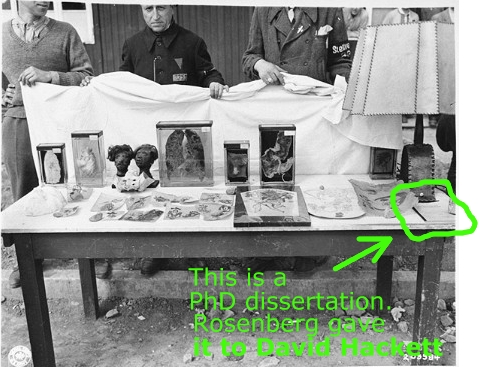
Of all the table items above, I believe that David Hackett has the only
remaining object. He has the dissertation, because
Albert G. Rosenberg gave it to him.
In a phone conversation, and before I told him I was a denier
(he won't respond to me now) Professor David A. Hackett, the translator of "The
Buchenwald Report" told me that among all the papers that Rosenberg gave him
around 40 to 50 years after the war, was this dissertation, written by a German
doctor who was studying a perceived connection between criminality and tattoos.
(Common criminals were a significant part of the inmate population at
Buchenwald.) Hackett told me that he'd read the dissertation and it was of
really poor-quality scholarship.
But consider that the dissertation is a piece of withheld
evidence. Ilse Koch's lawyers would have liked to have known about it. After
all, it could have helped exonerate Koch from the incredibly cruel charges that
she made lampshades out of human skin. Her lawyers could have offered an
alternate explanation, using the dissertation to bolster the notion that
tattooed skin was at the camp because a student had been studying the skin.
Similarly, the Nuremberg defendants' lawyers would have also wanted to see it,
since they could have used it to offer an explanation as to why tattooed skin
was found at Buchenwald. The Germans' lawyers probably never knew the
dissertation existed.
During various trials, Rosenberg had this evidence and
withheld it.
Does the dissertation mention anything about tribalism?
Hackett won't answer my emails.
The dissertation is the only thing on the table that is known
to be in existence today. Rosenberg gave it to Hackett in the 1980's or 1990's
and Hackett currently possesses it. In my nearly two-hour phone conversation
with Rosenberg, he told me that he "burned half of the reports" he had lying
around from his days in Psych Warfare. Did he also get rid of things like the
"human pelvis ashtray"? One wonders.
Imagine this withheld piece of evidence, in trials where
people were sentenced to death long ago in Germany, probably sitting in the
bottom of some box in some garage in El Paso, Texas; as kids ride their Razor
scooters by on the hot asphalt street out in front.
It would be helpful if Professor Hackett could use a digital
camera, and take photos of the pages of the dissertation and put them on his
website so that others can take a look at this German language document
Nazi Shrunken Heads
The lampshade and tattooed-skin charges were made against Ilse Koch, dubbed by journalists the "Bitch of Buchenwald," who was reported to have furnished her house with objects manufactured from the tanned hides of luckless inmates. But General Lucius Clay, military governor of the U.S. zone of occupied Germany, who reviewed her case in 1948, told his superiors in Washington: "There is no convincing evidence that she [Ilse Koch] selected inmates for extermination in order to secure tattooed skins or that she possessed any articles made of human skin." In an interview General Clay gave years later, he stated about the material for the infamous lampshades: "Well, it turned out actually that it was goat flesh. But at the trial it was still human flesh. It was almost impossible for her to have gotten a fair trial."(8) Ilse Koch hanged herself in a West German jail in 1967. The Liberation of the Camps by Theodore J. O'Keefe
The German court found Ilse Koch guilty of one count of incitement to murder, one count of incitement to attempted murder, five counts of incitement to severe physical mistreatment of prisoners, and two counts of physical mistreatment. In January 1951, she was again sentenced to life in prison. While not finding her guilty of ordering prisoners killed for their tattooed skin, the court did take judicial notice that there was no doubt that lamp shades made from human skin had been found at Buchenwald, even though it had not been proved that Ilse Koch had ordered these lamp shades to be made. Ilse protested her life sentence, to no avail, to the International Human Rights Commission. After serving over 20 years in prison, Ilse was founded dead in her cell at Aichach on September 1, 1967. Her death, by hanging, was ruled a suicide. The Trial of Ilse Koch
Morgen worked as both investigator and judge prosecuting officials and
guards in the concentration camps for illegal activities. In the Buchenwald
camp, four people were arrested, including the former camp commander's wife,
Ilse Koch. The main issue was that 3-4 prisoners had been killed some years
earlier. Morgen sentenced two of them to death. Ilse was acquitted on the charge
of embezzlement, and the charge against her levelled by the inmates of making
items out of human skin was withdrawn due to lack of evidence. Morgen had
interviewed the prisoners at Buchenwald, but couldn't prove their stories about
Ilse making tattooed lamp shades so he withdrew the charge.
....What Morgan did during the war flies in the face of the standard holocaust
story: Morgen sentenced to death the top two officials of a concentration camp
for killing just 3-4 inmates, years earlier. Not hundreds, not thousands. Yet
holocaust survivor stories tend to describe the average guard as killing that
many people every day, with and without an alcoholic drink in one hand. Contrast
with Morgen: he moved to the Buchenwald area for 8 months, and had to really
look, placing his staff to live in the concentration camp itself. He wasn't
investigating the current camp commander Hermann Pister, but rather the former
camp commander who had left 2 years earlier. After some major sleuthing, Morgen
found some corruption practices but turned up no murder leads. Finally, near the
end of 8 months, and looking at records that were 3-5 years old, Morgen
uncovered a stealthy way in which the camp commander, Karl Koch, with the help
of the camp doctor had killed around 4 inmates, and Koch was tried and sentenced
to death. That doesn't fit with the holocaust at all does it? In short, Morgen
spent an enormous amount of time in regard to the deaths of a few inmates that
had occurred years before.
Konrad Morgen
The Allied Psychological Warfare Department (called PWD-SHAEF) came up with a plan to exploit a rumor which they had heard about. The rumor was that at Buchenwald, Ilse Koch, the sadistic wife of the camp commander Karl Koch, would ride out into the prison yard on a horse, have prisoners strip, and then choose tattoos on their bodies she liked. These prisoners would then be sent to a place where they would be killed, so that their tattooed skin could be removed and made into lampshades and other items. Konrad Morgen
The Buchenwald Report, translated, edited, and with an introduction by David
A. Hackett, Westview Press, 1995
Professor David A. Hackett, who is not a holocaust denier, documents this in the
introduction of his book, page 5. The book is a translation of the 1945 "The
Buchenwald Report."
Hackett inadvertently reveals that nearly everyone in psyche warfare involved
regarding Buchenwald was Jewish. You can tell from their names: Edward A.
Tenenbaum, Albert G. Rosenberg, Daniel Lerner, Saul Padover. Rosenberg was
German Jewish. Tenenbaum was American Jewish. Jews were probably around 2
percent of the US population at the time. Tenenbaum was the first American to
arrive at the camp along with a civilian named Egon Fleck. On page 5 of
Hackett's book, it mentions that Tenenbaum stayed overnight in block 50. Maps
show that that is in the medical experiments area, which would have been the
right place to plant skin and shrunken heads. Then again Rosenberg could have
planted them when he arrived 5 days later.
Then shortly after, an American film crew arrived, headed by
Billy Wilder, an Austrian Jew turned American Film Corps officer, and lo and
behold, there on a display table ready to be filmed were dried pieces of
tattooed human skin. Oh, and two shrunken heads. Never mind that they were South
American shrunken heads.
Konrad Morgen
The Logic of The Psych Warfare Plan: Ilse Koch was killing prisoners
and making items out of their tattooed skin. When the Americans were coming in
April 1945, she hastily left, and morbid objects indicating what she had done
were there for the Americans to find.
Konrad Morgen
The Problem with The Psych Warfare Plan: If Psych Warfare had known about
Konrad Morgen, they might have done the math. The math is that no one associated
with the rumor of the tattooed skin, shrunken heads, and lampshades had been at
Buchenwald for almost two years. Morgen had arrested four people: Karl Koch, his
wife, the deputy camp commander, and the lead camp doctor, all in late 1943. In
the subsequent trial the charge against Ilse Koch regarding making items out of
skin was withdrawn due to lack of evidence, (20) and Ilse
was acquitted on the charge of embezzlement, but her husband was found guilty of
murdering 4 inmates. He was sentenced to death and later executed, as was the
deputy. When the Americans arrived, Ilse Koch hadn't lived at Buchenwald for
almost 2 years. And during the Morgen crackdown, one would think the camp would
have been run by the book. The new commander of Buchenwald, Hermann Pister, was
already there in July 1943 when Morgen started his 8 month investigation. Karl
Koch had transferred to be the head of Majdanek in 1941. The new commander,
Hermann Pister, was never charged by the SS nor later the Americans with making
shrunken heads or procurring human skin, so it doesn't make sense that the
Americans would find these items when they arrived almost 2 years later. Morgen
threw a wrench into the works of the Psych Warfare plan, because they didn't
know about him.
But the plan worked anyway, because when it comes to a
psychologically powerful atrocity spectacle, the public doesn't really think.
That could be seen in 1991, when a Hungarian Jew turned US congressman, Tom
Lantos, staged a spectacle: A 15 year-old girl testified that she had been in a
Kuwait hospital room when the Iraqi soldiers came in and yanked babies off
life-support systems so they could take the incubators back to Iraq. No one
noticed that the girl testifying spoke perfect American English. She had no
accent whatsoever. What are the chances of a 15 year old Arab girl in Kuwait
speaking flawless American English happening to be in the neo-natal intensive
care unit when Iraqi troops barge in? The horrible spectacle she described, her
brown skin, and her Arabic name was enough to fool everybody.
Konrad Morgen
So Morgen's name enters the court transcript, but as part of a lie Dodd is telling in order to save the integrity of his presentation. Because Morgen never saw a head, tattoos and lampshades in his investigation of Buchenwald. And as mentioned, that charge against Ilse Koch was withdrawn due to lack of evidence. At that point, around January 1946, the Americans start looking for Morgen in Germany. When they find him, they imprison him at Dachau and threaten to turn him over to the Soviets if he doesn't testify that he saw the tattooed human skin, lampshades and shrunken heads. He refuses. Konrad Morgen
